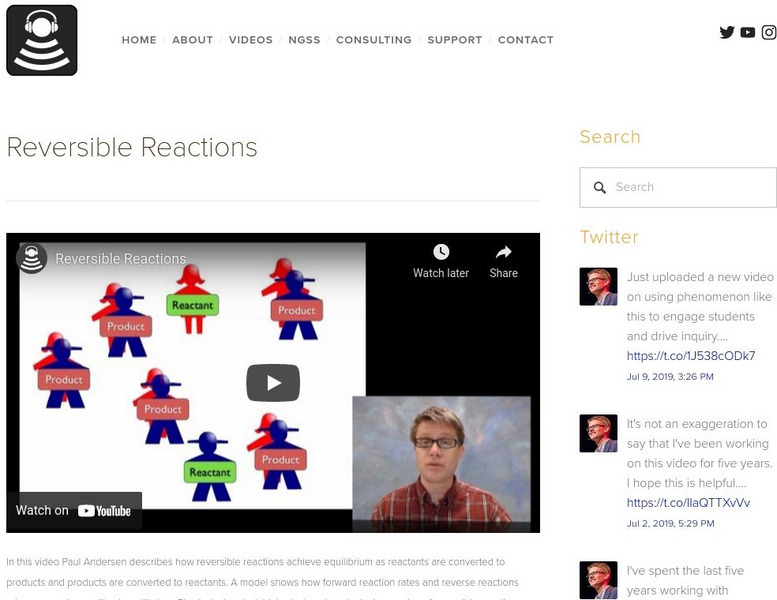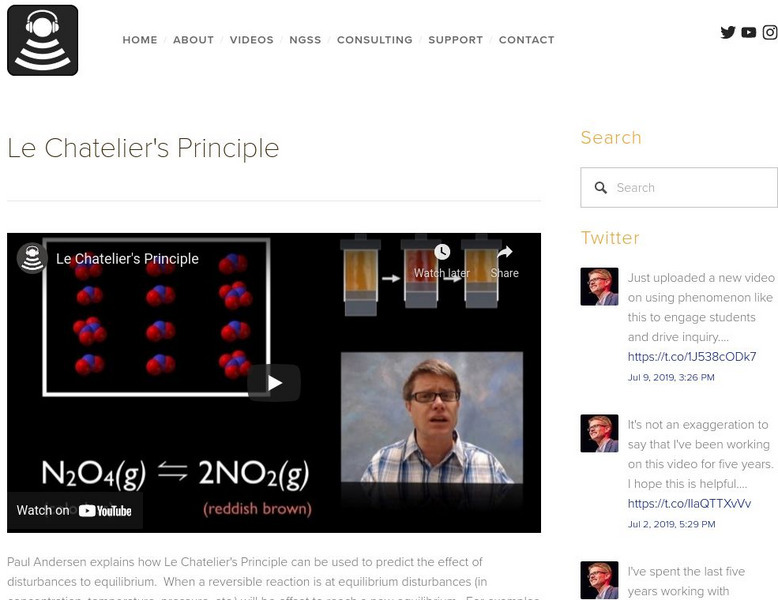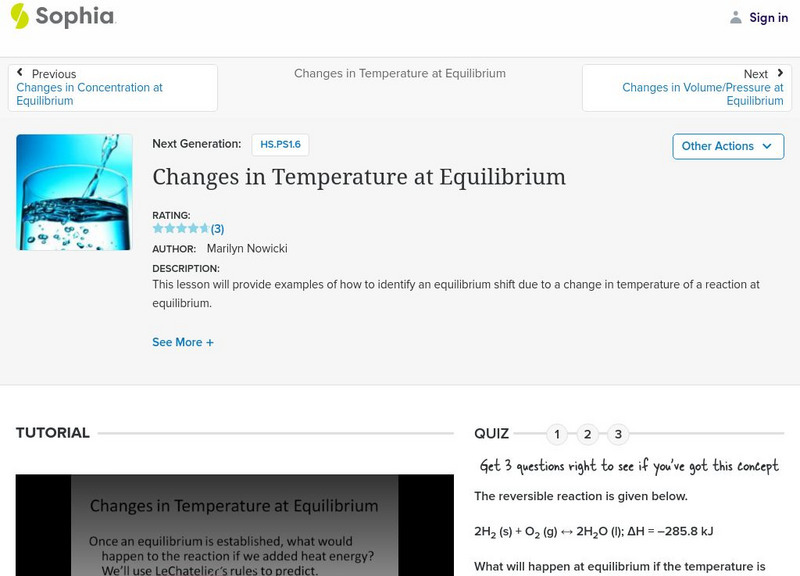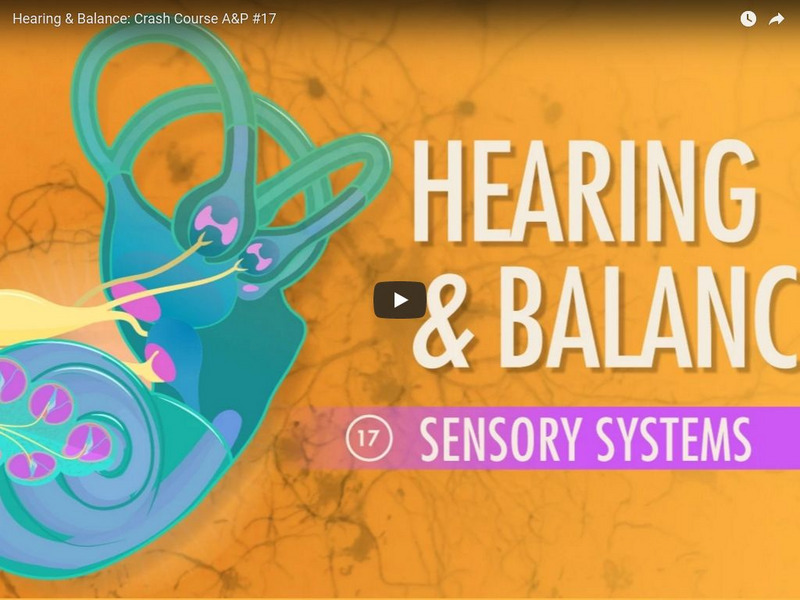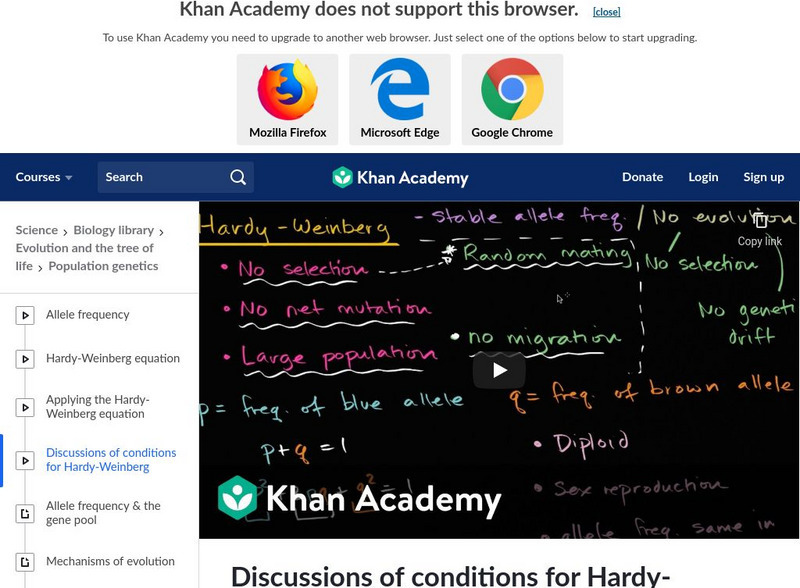Hi, what do you want to do?
Khan Academy
Khan Academy: Chemistry: Reaction in Equilibrium
In this video module explore how equilibrium in a chemical reaction is defined as when the rate going forward is equal to the rate of the reverse reaction. Also learn how to calculate the equilibrium constant by knowing the concentration...
PBS
Pbs Learning Media: Crash Course Anatomy and Physiology: Hearing & Balance
Continue on a journey through the sensory systems with a look at how your sense of hearing works. We follow sounds as they work there way into the ear, where they are registered and transformed into action potentials. This mechanism not...
Sophia Learning
Sophia: Define Equilibrium
This lesson will define equilibrium as the rate of the forward reaction equal to the rate of the reverse reaction, explaining that this does NOT mean that amounts of products and reactants are equal.
Sophia Learning
Sophia: Equilibrium Constant Calculation: Lesson 2
This lesson will demonstrate how to calculate the equilibrium constant of a reaction. It is 2 of 2 in the series titled "Equilibrium Constant Calculation."
Sophia Learning
Sophia: Equilibrium Constant of a Reversible Reaction: Lesson 1
This lesson will define the equilibrium constant of a reversible reaction. It is 1 of 2 in the series titled "Equilibrium Constant of a Reversible Reaction."
Sophia Learning
Sophia: Factors Affecting Equilibrium
This lesson will explain that when an equilibrium is disturbed, the reactants and products will respond in such a way as to re-establish the equilibrium. Identify that changes in concentration, temperature, pressure, and volume can...
Bozeman Science
Bozeman Science: Simple Harmonic Motion
In the following video Paul Andersen explains how simple harmonic motion occurs when a restoring force returns an object toward equilibrium. The two types of harmonic motion studied in AP Physics are the mass spring oscillator and the...
Bozeman Science
Bozeman Science: Reversible Reactions
In this video Paul Andersen describes how reversible reactions achieve equilibrium as reactants are converted to products and products are converted to reactants. A model shows how forward reaction rates and reverse reactions rates...
Bozeman Science
Bozeman Science: Reaction Quotient
In the following video Paul Andersen explains how the reaction quotient is used to determine the progress of a reversible reaction. The reaction quotient (Q) is the ratio of the concentration of products to the concentration of...
Bozeman Science
Bozeman Science: Equilibrium
In the following video Paul Andersen explains how equilibrium is achieved in a reversible reaction. When the rate of the forward reaction is equal to the rate of the reverse reaction the system is at equilibrium. Graphical analysis of...
Bozeman Science
Bozeman Science: Le Chatelier's Principle
In the following video Paul Andersen explains how Le Chatelier's Principle can be used to predict the effect of disturbances to equilibrium. When a reversible reaction is at equilibrium disturbances will be offset to reach a new...
Bozeman Science
Bozeman Science: Equilibrium Disturbances
In the following video Paul Andersen explains how disturbances to a reversible reaction at equilibrium affect the equilibrium constant and the reaction quotient. For example if the concentration is changed the reaction will move to...
Bozeman Science
Bozeman Science: Equilibrium Reasoning
Paul Andersen explains how acid-base chemistry can be understood in terms of equilibrium. Water is present in all acid-base chemistry and is amphoteric in nature. The Ka and Kb values can be used to determine the strength of an acid or a...
Sophia Learning
Sophia: Changes in Temperature at Equilibrium
This lesson will provide examples of how to identify an equilibrium shift due to a change in temperature of a reaction at equilibrium.
Crash Course
Crash Course Chemistry #28: Equilibrium
Learn about chemical equilibrium, concentration, temperature, and pressure in this Crash Course Chemistry tutorial. [10:57]
Crash Course
Crash Course A&p #17: Sensory Systems: Hearing and Balance
Crash Course A&P continues the journey through sensory systems with a look at how your sense of hearing works. We follow sounds as they work their way into the ear where they are registered and transformed into action potentials....
Khan Academy
Khan Academy: Chemistry: Macrostates and Microstates
A video lecture exploring the difference between macrostates, microstates, and thermodynamic equilibrium. Understand how macrostates is best defined when the system is in thermal equilibrium and describes pressure, temperature, and...
Khan Academy
Khan Academy: Chemistry: Quasi Static and Reversible Processes
Understand that an almost static process is called quasi-static process in this video lecture. Also explained is how all reversible processes are quasi-static but not all quasi-static processes are reversible. Video lecture gives...
Khan Academy
Khan Academy: Measurement: 2 D Equilibrium Balancing Games
How does everything even out? Learn what 2D Equilibrium is and how it effects the balance of life.
Khan Academy
Khan Academy: Deadweight Loss: Taxation and Dead Weight Loss
Video lecture discusses the effect of taxation on the equilibrium price and quantity. [9:06]
Sophia Learning
Sophia: Economics: Price Ceiling
Video lesson describes how the government attempts to control prices through price ceilings; an example being rent control on apartments. [4:51]
Sophia Learning
Sophia: Practice With Equilibrium
A video tutorial which allows students to practice mechanical equilibrium problems. [8:50]
Khan Academy
Khan Academy: Discussions of Conditions for Hardy Weinberg
An overview of what happens when the conditions for Hardy-Weinberg equilibrium are not fulfilled. [6:54]
Khan Academy
Khan Academy: Chemistry: Keq Intuition
A video lecture showing how the equilibrium constant is derived. Understand how equilibrium in a reaction is reached when the forward reaction rate equals the reverse reaction rate. The video explores how knowing the concentrations of...












